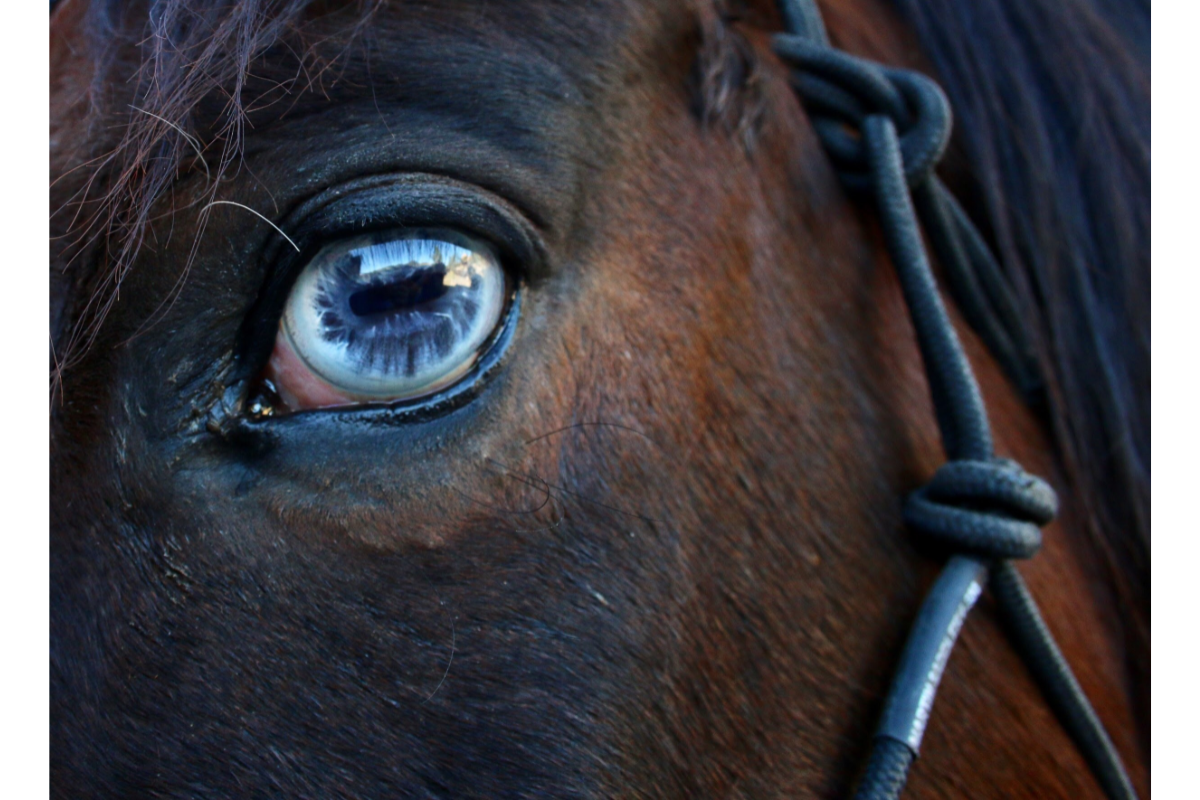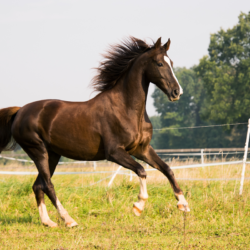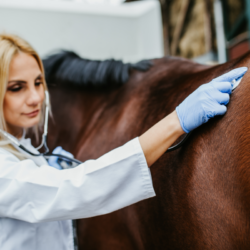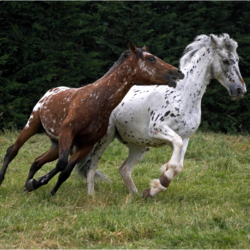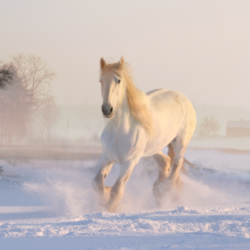Uveitis, one of the most common eye diseases in horses, is a major cause of blindness. Characterised by painful inflammation of the uvea, this recurring disease poses a significant challenge for horse owners.
What causes this disease?
Uveitis in horses manifests itself as inflammation of the uvea, the vascular part of the eye made up of the iris, ciliary body and choroid. The causes of this inflammation are varied and often multiple.
- Ocular trauma: A blow or injury to the eye can cause uveitis. This type of lesion is often isolated and generally does not recur after healing.
- Photosensitisation: Intoxication can lead to uveitis, often accompanied by marked corneal oedema and burning of the lids.
- Immune origin: Recurrent uveitis is often linked to an immune reaction in which the eye’s defences turn against itself. This autoimmunity is particularly observed in genetically predisposed horses, such as Appaloosas.
- Bacterial infections: Leptospirosis, an infection by a bacterium of the Spirochete family, is a major cause of recurrent uveitis. Antibodies produced against this bacterium also attack the eye, causing recurrences even after the bacterium has been eliminated.
- Systemic diseases: Lyme disease is also linked to the development of uveitis. Although the exact mechanism is not completely understood, it is clear that this infection can have severe consequences for the eye.
The combination of these factors makes uveitis a complex disease to manage. Each inflammatory episode increases the risk of sequelae and vision loss, underlining the importance of early diagnosis and appropriate management.
What are the symptoms of uveitis?
The symptoms of uveitis vary depending on the severity of the inflammation, its stage and location. However, the most common sign is eye pain, often manifested by a closed eye and sensitivity to light.
- Blepharospasm: Contractions of the eyelid muscles, keeping the eye closed.
- Epiphora: More or less abundant lacrimal discharge.
- Photophobia: Sensitivity to light.
- Myosis: Contraction of the pupil.
- Change in eye colour: The eye may turn red or yellow, particularly noticeable in blue eyes.
- Corneal oedema: The eye appears to be covered by a blue veil.
- Eyelid oedema: Swelling of the eyelids.
- Reduced vision or blindness: In severe cases, vision may be significantly reduced or even completely lost.
- Hyperthermia, depression or anorexia: These general signs may accompany the eye symptoms.
The pain and repeated inflammation can lead to severe complications such as cataracts, glaucoma and, more rarely, retinal detachment. Each episode of uveitis worsens the condition of the eye and makes pain management increasingly difficult, making it a worrying condition requiring immediate veterinary attention.
How is it diagnosed?
To correctly diagnose uveitis in horses, the vet needs a detailed set of information.
Preliminary information :
- Date of onset of first signs, including circumstances and course of symptoms.
- History of previous treatment for uveitis or other general diseases.
This information is crucial in determining whether uveitis is recurrent, which implies long-term management. To test for pathogens such as Leptospirosis, an ocular fluid puncture is required for serological and PCR analysis. This method is more accurate than blood antibody testing.
Genetic tests can be carried out to identify predispositions, particularly in breeds such as Appaloosas. Aetiological diagnosis helps to understand the underlying causes, but the dysimmune nature of recurrences limits the effectiveness of antibiotic treatment. Appropriate treatment therefore depends on a full understanding of medical history and genetic predisposition.
What treatments are available?
The main aims of uveitis treatment are to relieve pain and reduce inflammation, while preserving vision and eye health in the long term.
- Symptomatic treatment during the attack: Use of mydriatics (eye drops that dilate the pupil) and corticosteroid-based anti-inflammatory eye drops. If corneal lesions are present, immunomodulators and antibiotics replace corticoids.
- Isolation in the dark: The horse should be kept in a dark environment to limit pain and inflammation. An anti-UV mask is recommended to protect the affected eye.
- Long-term hygiene measures: Use of a fly cap with UV protection, reducing exposure to wind and dust.
In terms of eye surgery , two promising techniques are available:
- Cyclosporine implant: Insertion of an implant releasing an immunosuppressant to reduce inflammation, effective for 2-3 years.
- Vitrectomy: aspiration of the inflamed vitreous body to remove the antibodies responsible for recurrences, preventing around 90% of relapses.
Other options may also be considered:
- Gentamicin injection: This injection into the vitreous body can reduce symptoms in some horses. However, the vet must assess the risks and benefits.
- Enucleation: If pain persists and other treatments are ineffective, removal of the eye may be necessary to improve the animal’s comfort.
Early and appropriate treatment is crucial to limit the after-effects and preserve the horse’s vision. Early recognition of symptoms and rigorous management of recurrences are essential.
What are the natural alternatives?
Bilberry is rich in antioxidants that are beneficial to ocular blood circulation. It is used to treat chronic uveitis, nuclear sclerosis, progressive retinal atrophy and to prevent cataracts in older horses. Bilberry improves eye fatigue and circulatory disorders, particularly in the limbs.
Euphrasia, also known as eyebright, has soothing, antibacterial and anti-inflammatory properties, making it an ideal plant for eye ailments.
Ginkgo Biloba delays eye ageing thanks to its effects on blood micro-circulation. It is recommended for older horses and is effective against eye burns, watery eyes and conjunctivitis.
Maintaining regular eye hygiene with a saline-based lotion and cornflower water helps prevent infection and irritation. These natural alternatives offer complementary options for the management and prevention of eye conditions, while supporting the horse’s overall health.
What are the means of prevention?
Prevention of uveitis is based on several key measures to minimise the risks and recurrences.
- Eye cleanliness: Regularly clean your horse’s eyes with a suitable eye lotion.
- Insect and UV protection: Use a fly mask with UV protection to avoid irritation caused by insects and sun exposure.
- Feed and supplements: Include foods rich in antioxidants, such as bilberry, to support eye health.
- Stress management: Limit exposure to wind, dust and extreme weather conditions.
- Regular monitoring: Carry out frequent eye checks to detect the first signs of uveitis.
- Vaccinations and preventive treatments: Reduce the risk of infections that can trigger recurrent uveitis.
- Handling: Avoid eye injuries by handling horses with care.
By adopting these preventive measures, owners can significantly reduce the risk of uveitis and protect their horses’ vision in the long term.

